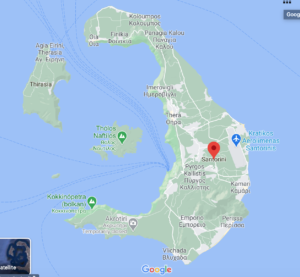Santorini, Greece
The Greek Island of Santorini is located on the southern end of the Aegean Sea. The island is merely 16 km in length with a varying width that maxes out at 5 km, meaning that a round trip can take upwards of 40 to 45 minutes (Santorinidave, n.d.). Originally the island was named Strogili before a volcanic eruption separated the land into three islands, Aspronisi, Therasia, and Santorini as well as Palaia Kammeni and Nea Kammeni (SantoriniView, n.d.). Since then the name has been changed due to different rulers over time but officially the island is named Thira, though it is primarily known as Santorini by the Greeks (SantoriniView, n.d.). According to Santorini.Net (n.d.), the official tourism site for the island group, Santorini has a total surface/land area of 73 km2 with a total population of 15,500 as per a 2011 census. Permanent residents with Greek heritage make up a majority of that population and the remaining 3,174 residents are of other heritages (Thira Municipality, 2011). Leisure travel statistics provided by Statista (2020) show that in 2018 there was a recorded total of 507,213 international tourists and in the following year, 2019, there was a recorded total of 519,999 international tourists who visited the island. Santorini relies heavily on tourism as it makes up 90% of the total income earned with the remaining 10% of the total income being made from agriculture and wineries (Micallef, 2019 & Mourby, 2020). The wine produced on Santorini is crafted from a variety of Greek indigenous grapes and is highly sought-after for its sweetness and richness, though due to land spacing issues wine production yields low quantities making it an unviable option in comparison to the tourism industry (Micallef, 2019). The official language spoken on Santorini is Greek though because of tourism most locals and tourism operators are able to speak fluent English and are able to hold a general conversation if tourists need assistance (SantoriniView, n.d.). Overall Santorini is a beautiful destination with a heavy reliance on the tourism industry for its means of income and the culture surrounding the island is deeply rooted in Greek ancestry and history while being welcoming to international guests who may not speak the official language.

The Greek Island of Santorini is located on the southern end of the Aegean Sea. The island is merely 16 km in length with a varying width that maxes out at 5 km, meaning that a round trip can take upwards of 40 to 45 minutes (Santorinidave, n.d.). Originally the island was named Strogili before a volcanic eruption separated the land into three islands, Aspronisi, Therasia, and Santorini as well as Palaia Kammeni and Nea Kammeni (SantoriniView, n.d.). Since then the name has been changed due to different rulers over time but officially the island is named Thira, though it is primarily known as Santorini by the Greeks (SantoriniView, n.d.). According to Santorini.Net (n.d.), the official tourism site for the island group, Santorini has a total surface/land area of 73 km2 with a total population of 15,500 as per a 2011 census. Permanent residents with Greek heritage make up a majority of that population and the remaining 3,174 residents are of other heritages (Thira Municipality, 2011). Leisure travel statistics provided by Statista (2020) show that in 2018 there was a recorded total of 507,213 international tourists and in the following year, 2019, there was a recorded total of 519,999 international tourists who visited the island. Santorini relies heavily on tourism as it makes up 90% of the total income earned with the remaining 10% of the total income being made from agriculture and wineries (Micallef, 2019 & Mourby, 2020). The wine produced on Santorini is crafted from a variety of Greek indigenous grapes and is highly sought-after for its sweetness and richness, though due to land spacing issues wine production yields low quantities making it an unviable option in comparison to the tourism industry (Micallef, 2019). The official language spoken on Santorini is Greek though because of tourism most locals and tourism operators are able to speak fluent English and are able to hold a general conversation if tourists need assistance (SantoriniView, n.d.). Overall Santorini is a beautiful destination with a heavy reliance on the tourism industry for its means of income and the culture surrounding the island is deeply rooted in Greek ancestry and history while being welcoming to international guests who may not speak the official language.